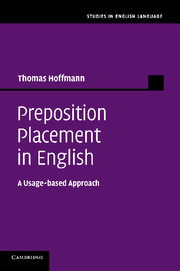Book contents
- Frontmatter
- Contents
- List of Figures
- List of Tables
- List of Abbreviations
- Acknowledgements
- 1 Introduction
- 2 Corroborating evidence: Data and methodology
- 3 Case notes: Independent factors
- 4 Evidence I: Corpus results
- 5 Evidence II: Experimental results
- 6 Preposition placement: The case for a Construction Grammar account
- 7 Conclusion: The verdict
- Online appendix
- References
- Index
6 - Preposition placement: The case for a Construction Grammar account
Published online by Cambridge University Press: 04 February 2011
- Frontmatter
- Contents
- List of Figures
- List of Tables
- List of Abbreviations
- Acknowledgements
- 1 Introduction
- 2 Corroborating evidence: Data and methodology
- 3 Case notes: Independent factors
- 4 Evidence I: Corpus results
- 5 Evidence II: Experimental results
- 6 Preposition placement: The case for a Construction Grammar account
- 7 Conclusion: The verdict
- Online appendix
- References
- Index
Summary
Construction Grammar: A descriptively and explanatorily adequate linguistic theory
The previous two chapters were an attempt at providing an observationally adequate description of preposition placement in British and Kenyan English: employing empirical methods, various language-internal and -external factors were statistically identified as affecting preposition-stranding and pied-piping. Most modern theories of linguistics, however, do not stop at merely charting the distribution of grammatical phenomena. Instead, it is commonly accepted that all linguistic performance is the product of a cognitive mental system. Accordingly, the two main goals of such theories are to describe this mental system (also known as a speaker's competence) and to explain how children can acquire it. If a grammar is successful at providing a description of the linguistic competence of speakers it is labelled ‘descriptively adequate’ (Chomsky 1965: 24). If it furthermore gives a correct account of the language acquisition process, a grammar can be also said to be ‘explanatorily adequate’ (Chomsky 1965: 25–6).
One well-known framework aiming at these goals is Noam Chomsky's Principles-and-Parameters theory (for the various stages from Standard Theory to Minimalist Program, see Chomsky 1965, 1981, 1995, 2001). Assuming the existence of an innate language faculty (called Universal Grammar), proponents of this theory claim to have achieved a high level of descriptive and explanatory adequacy. Yet, as, for example, Culicover and Jackendoff (cf. 2005: 25–37) have pointed out, this alleged success is only achieved by ignoring a great number of linguistic phenomena.
Information
- Type
- Chapter
- Information
- Preposition Placement in EnglishA Usage-based Approach, pp. 226 - 275Publisher: Cambridge University PressPrint publication year: 2011
